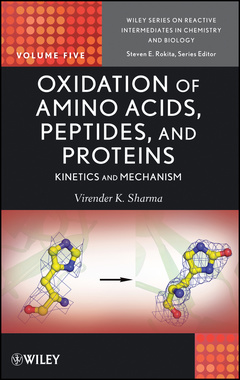Description
Oxidation of Amino Acids, Peptides, and Proteins
Author: SHARMA Virender K.
Language: English
Approximative price 148.91 €
In Print (Delivery period: 12 days).
Add to cart
Publication date: 12-2012
Description
/li>Contents
/li>
This book summarizes the chemical mechanisms and detailed kinetics of amino acid and peptide oxidation to help understand how proteins break down or dissociate when under stress in biological and environmental systems so that new drugs and antioxidants may be developed. It provides a summary of fundamental information on the kinetics and mechanism of amino acids by various oxidants. It also discusses oxidative chemistry of amino acids, peptides, and proteins. This useful guide also provides problems and their solutions associated with amino acids, peptides, and proteins in the aquatic environment.
PREFACE TO SERIES xiii INTRODUCTION xv 1 Reactive Species 1 1.1 Diseases 3 1.1.1 Neurodegenerative Diseases 3 1.1.1.1 Alzheimers Disease 5 1.1.1.2 Parkinson’s Disease 5 1.1.2 Metals in Human Diseases 6 1.2 Protein Structure 9 1.2.1 Oxidative Labeling 10 1.2.1.1 Carbonyl Labeling 10 1.2.1.2 Cysteine Residue Labeling 10 1.2.1.3 Reactive Species Labeling 10 1.2.1.4 Hydroxyl Radical Labeling 12 1.2.2 Other Techniques 13 1.3 Reactive Species 20 1.3.1 Halogen Species 20 1.3.2 Oxygen Species 21 1.3.3 Nitrogen Species 22 1.3.4 Sulfur Species 22 1.3.5 High–Valent Cr, Mn, and Fe Species 25 1.4 Reactive Species in Environmental Processes 26 1.4.1 Atmospheric Environment 26 1.4.2 Disinfection By–Products (DBP) 27 1.4.3 Oxidation Processes for Purifying Water 29 References 30 2 Acid–Base Properties 52 2.1 Dissociation Constants 54 2.2 Speciation 62 2.2.1 Protonation 62 2.2.2 Metal Complexes 63 2.2.2.1 Iron 64 2.2.2.2 Copper, Zinc, and Nickel 66 References 69 3 Halogenated Species 78 3.1 Hypohalogens 79 3.1.1 Hypochlorite 79 3.1.1.1 Kinetics of HOCl 79 3.1.1.2 Products of HOCl Oxidation 83 3.1.2 Hypobromite 88 3.1.2.1 Kinetics of HOBr 88 3.1.2.2 Products of HOBr Oxidation 89 3.1.3 Hypothiocyanous 90 3.1.3.1 Kinetics of HOSCN 91 3.1.3.2 Products of HOSCN Oxidation 92 3.2 Halamines 93 3.2.1 Hydrolysis of Halamines 93 3.2.2 Halogen Transfer by Halamines 94 3.2.3 Reduction of Halamines 96 3.3 Chlorine Dioxide 96 3.3.1 Generation of ClO2 101 3.3.2 Decomposition of ClO2 101 3.3.3 Reactivity of ClO2 104 3.3.3.1 Amino Acids, Peptides, and Proteins 104 3.4 Conclusions 109 References 110 4 Reactive Oxygen Species 122 4.1 Superoxide 122 4.1.1 Generation 122 4.1.2 Properties 123 4.1.3 Reactivity 125 4.1.4 Metalloenzymes 129 4.1.4.1 Manganese Superoxide Dismutase 131 4.1.4.2 Iron Superoxide Dismutase 134 4.1.4.3 Iron Superoxide Reductase (FeSOR) 135 4.2 Singlet Oxygen 140 4.2.1 Reactivity 142 4.3 Ozone 153 4.3.1 Reactivity 154 4.4 Hydroxyl Radical 162 4.4.1 Generation 162 4.4.2 Reactivity 164 4.4.2.1 Main–Chain Cleavage of Protein 165 4.4.2.2 Oxidation of Amino Acid Side Chains 169 Aliphatic Side Chains 169 Sulfur–Containing Side Chains 172 Acidic Side Chains 175 Basic Side Chains 175 Aromatic Side Chains 177 4.5 Conclusions 179 References 182 5 Reactive Inorganic Oxy–Species of C, N, S, and P 205 5.1 Carbon Species 206 5.1.1 Carbonate Radical 206 5.1.1.1 Generation and Properties 206 5.1.1.2 Reactivity 210 5.1.2 Peroxymonocarbonate 217 5.1.2.1 Reactivity 217 5.1.3 Carboxyl Radical 219 5.2 Nitrogen Species 220 5.2.1 Nitrogen Monoxide 220 5.2.2 Nitrogen Dioxide Radical 223 5.2.3 Peroxynitrite 224 5.2.3.1 Generation 224 5.2.3.2 Decomposition in Aqueous Solution 226 5.2.3.3 Reactivity with CO2 228 5.2.3.4 Reactivity with Inorganic and Organic Substrates 229 5.2.3.5 Reactivity with Proteins and Nonprotein Metal Centers 231 5.2.3.6 Reactivity with Amino Acids, Peptides, and Proteins 233 5.3 Sulfur Species 241 5.3.1 Oxysulfur Radicals 241 5.3.1.1 Generation 241 5.3.1.2 Reactivity 244 5.4 Phosphorous Species 246 5.4.1 Phosphate Radicals 246 5.4.1.1 Generation, Equilibria, and Spectral Characteristics 247 5.4.1.2 Reactivity 248 5.5 Conclusions 250 References 252 6 High–Valent Cr, Mn, and Fe Species 278 6.1 Chromium 279 6.1.1 Aqueous Chemistry of Oxo–Cr Compounds 280 6.1.1.1 Cr(III) 280 6.1.1.2 Cr(VI) 280 6.1.1.3 Cr(III) Superoxo and Hydroperoxo Complexes 281 6.1.1.4 Aqueous Cr(IV) Ion 281 Acid medium 281 Alkaline Medium 282 6.1.1.5 Cr(V) 283 6.1.2 Chromium(VI, V, and IV) Complexes 284 6.1.3 Reduction of Cr(VI/V/IV) by Substrates 285 6.1.4 Reactivity of Cr Species 286 6.1.4.1 Fe(II) Complexes 286 6.1.4.2 Hydrogen Peroxide 287 6.1.4.3 Carbohydrates 287 6.1.4.4 Hydroxy Acids 287 6.1.4.5 Ascorbic Acid 288 6.1.4.6 Catecholamines 288 6.1.4.7 Thiols 289 6.1.4.8 Non–Sulfur–Containing Amino Acids and Peptides 291 6.1.4.9 Proteins 291 6.1.4.10 NADPH/NADP 292 6.1.4.11 Nitric Oxide Synthase (NOS) 292 6.1.5 Mechanism 292 6.1.6 Carcinogenesis 295 6.1.7 Genotoxicity and Cytotoxicity 298 6.1.8 Conclusions 302 6.2 Manganese 302 6.2.1 Aqueous Chemistry of Oxo–Mn Compounds 305 6.2.1.1 Mn(III) 305 6.2.1.2 Mn(IV) 308 6.2.1.3 Mn(V) and Mn(VI) 308 6.2.2 Reactivity of Complexes of Hypervalent Mn 312 6.2.3 Oxidation by Mn(VII) 313 6.2.3.1 Amino Acids 314 6.2.3.2 Aminopolycarboxylates (APCs) 319 6.2.4 Conclusions 322 6.3 Iron 322 6.3.1 Iron(IV) and Iron(V) 325 6.3.1.1 Ferryl(IV) Ion 325 6.3.1.2 Iron(IV)– and Iron(V)–Oxo Complexes 330 6.3.1.3 Ferrate(IV) 338 6.3.1.4 Ferrate(V) and Ferrate(VI) 339 6.3.2 Reactivity of Ferrate(V) and Ferrate(VI) 340 6.3.2.1 Amines 341 6.3.2.2 Amino Acids 343 6.3.2.3 Aminopolycarboxylates 353 6.3.3 Conclusions 356 References 357 INDEX 383
© 2024 LAVOISIER S.A.S.




